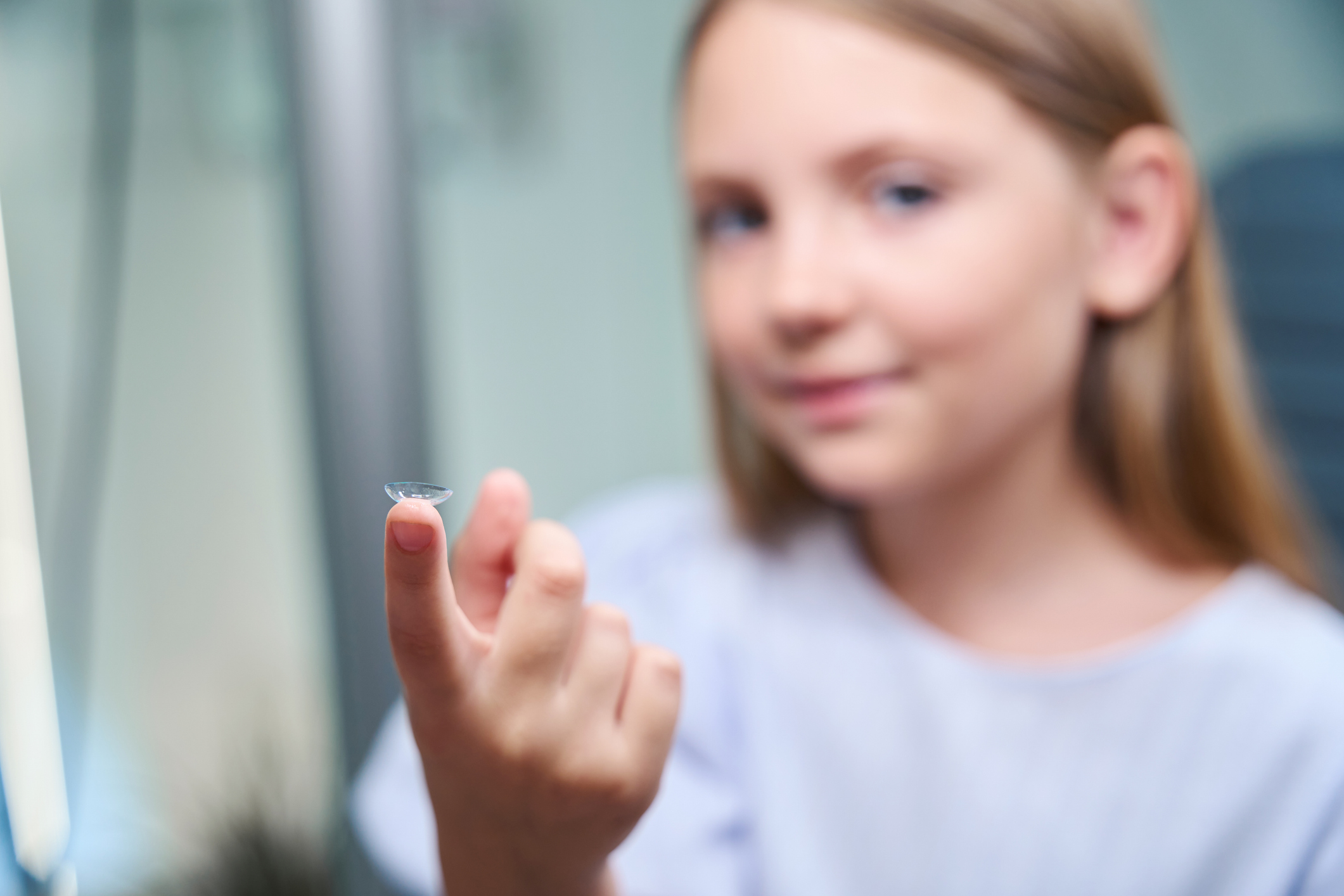What is Orthokeratology (Ortho-K)?
Orthokeratology, commonly known as Ortho-K, is a non-surgical and reversible method for correcting vision which also has a lot of evidence for slowing the worsening of childhood myopia (nearsightedness). Approved by both Health Canada and the U.S. FDA, Ortho-K involves wearing specially designed rigid contact lenses overnight. These lenses gently reshape the cornea overnight—the clear, dome-shaped front surface of the eye— and are removed on waking, giving the wearer clear vision throughout the day so that additional glasses or contact lenses are not needed.
This technology, also sometimes called Corneal Reshaping Therapy (CRT), relies on the forces of the eyelids and tears on the eye to temporarily modify the shape of the cornea overnight, to provide the clear vision throughout waking hours. Similar to how orthodontics correct teeth alignment, Ortho-K reshapes the cornea to correct the blurred vision from myopia, and also can slow down the typical progression, or worsening of myopia which is seen in children and teenagers.
Why Myopia Management Matters
Myopia (short-sightedness or near sightedness) causes blurred vision for objects across the room or out of a window, and is becoming increasingly common in children, with research showing that younger children tend to progress most rapidly.1 Unmanaged myopia can lead to increasingly higher prescriptions and this leads to increased risks of serious eye diseases, including retinal detachment, glaucoma, and myopic maculopathy later in life.2 This is why slowing myopia progression is critical, rather than just correcting vision each time it worsens.
Ortho-K is one of the leading options for myopia management, alongside specially designed glasses, soft contact lenses, and atropine eye drops. Research indicates that Ortho-K can slow myopia progression by about 50% (about half),3,4 making it a valuable choice for children at risk of worsening nearsightedness.
How Does Ortho-K Control Myopia?
While Ortho-K was initially used in adults after its discovery in the 1960s, its ability to slow myopia progression in children has made it increasingly popular. Though the exact mechanism is not fully understood, researchers believe that Ortho-K alters how light focuses inside the eye, creating a “stop signal” for the excessive eye growth which occurs in myopia. This unique focus pattern, where peripheral light rays are bent in front of the retina, helps to slow the rate of eye growth closer to the normal expected rate in childhood, which works to slow down myopia progression.5
To learn more about how Ortho-K is used for myopia control, you can read the article Ortho-K for myopia control on MyKidsVision.org.
Safety and Effectiveness of Ortho-K for Children
Numerous studies confirm that Ortho-K is a safe and effective option for children when proper lens care and hand hygiene steps are followed. While there is a small risk of eye infections, research suggests this risk is low—approximately 1-2 cases per 2,000 patient-wearing years.6,7 What this means is your child would need to wear Ortho-K for an average of 2,000 years to suffer one eye infection – a very low risk!
To ensure safe use of Ortho-K, it is important for parents and children to adhere to these guidelines:
- Maintain strict hand washing and hygiene practices when handling Ortho-K lenses.
- Follow the Optometrist’s instructions for Ortho-K lens cleaning and storage.
- Attend regular check-ups with an Optometrist experienced in Ortho-K fitting.
To learn more about Ortho-K safety, you can read the article Are Ortho-K lenses safe? On MyKidsVision.org.
Who Can Use Ortho-K?
Ortho-K is most effective to slow myopia progression when started early, ideally when myopia is first detected. While studies have included children as young as six,5 suitability depends on a child’s ability to handle the lenses and follow proper hand and Ortho-K lens hygiene steps. It is important for parents to work closely with an Optometrist to determine if their child is a good candidate for Ortho-K.
For myopia, Ortho-K is typically effective for glasses prescriptions up to -4.50 diopters (D) of myopia with up to -1.50D of astigmatism. This range is supported by government health approvals,5 confirming its safety and effectiveness within these parameters.
In some cases, Ortho-K can be used to correct higher levels of myopia, but the success rate may vary. The ability to achieve a successful outcome depends on individual eye characteristics, and higher prescriptions may reduce the likelihood of optimal correction.
Because Ortho-K suitability is influenced by multiple factors, any published prescription range should be viewed as a general guideline. The best way to determine eligibility for Ortho-K is to consult an Optometrist who can assess individual eye shape, glasses prescription, the shape of the cornea (called corneal topography), and other factors that contribute to successful treatment.
Long-Term Myopia Control with Ortho-K
Ortho-K lenses provide myopia control benefits when they are worn overnight, every night. If a child stops wearing the lenses, they won’t enjoy clear vision during the day and their myopia may resume progressing, sometimes at a faster rate (called a rebound effect). For this reason, continued monitoring by an Optometrist is necessary if there is any reason for stopping Ortho-K wear.8
Current research also explores altering Ortho-K lens designs to enhance their myopia control effect by increasing how peripheral light is focused. While promising, more long-term studies are needed to confirm these enhancements.
Parental Considerations and Commitment
Parents should be aware that successful Ortho-K treatment requires consistent overnight wear and careful hand washing and ortho-k lens hygiene practices. Ensuring a child follows proper cleaning routines and regularly attends check-ups with their Optometrist is essential to minimize risks and maximize benefits.
Financial considerations can come into play, as Ortho-K lenses may not be covered by standard health insurance plans. However, Optometrists may offer payment plans and given the potential long-term benefits of slowing myopia progression, the investment in Ortho-K can definitely be worthwhile.
Is Ortho-K Right for Your Child?
If your child has myopia and you are looking for a way to both give them great vision throughout their days and more stable vision between eye exams with less frequent changes in their vision, Ortho-K is a proven and effective option. With professional fitting and regular follow-ups, Ortho-K can provide children with clear vision in all waking hours, without needing to wear glasses or contact lenses during the day, while helping to protect their long-term vision and eye health.
If you are interested in Ortho-K for your child, speak with a qualified Optometrist who provides Ortho-K within their scope of practice. Early intervention is key—the sooner myopia control begins, the greater the potential benefits for your child’s vision.
What can you do next?
Here in Canada, Optometrists are the primary eye care professionals who diagnose and manage myopia. Many Optometrists across Canada now offer comprehensive myopia management programs, which include Ortho-K, specialized spectacle lenses, soft contact lenses, and atropine eye drops.
Ortho-K is a well-researched and effective option for both vision correction and myopia control. As part of a growing set of myopia management strategies, it provides children with the freedom from glasses and daytime contact lenses while reducing the long-term risks associated with progressive myopia.
Consulting an Optometrist experienced in Ortho-K fitting is the first step in determining whether this treatment is the right option for your child. Given the growing prevalence of myopia, early intervention and regular eye care are key to maintaining good vision and long-term eye health.
References
- Moore M, Lingham G, Flitcroft DI, Loughman J. Myopia progression patterns among paediatric patients in a clinical setting. Ophthalmic Physiol Opt. 2024 Mar;44(2):258-269.
- Bullimore MA, Ritchey ER, Shah S, Leveziel N, Bourne RRA, Flitcroft DI. The Risks and Benefits of Myopia Control. Ophthalmology. 2021 Nov;128(11):1561-1579.
- Sun Y, Xu F, Zhang T, Liu M, Wang D, Chen Y, Liu Q. Orthokeratology to control myopia progression: a meta-analysis. PLoS One. 2015 Apr 9;10(4):e0124535.
- Cho P, Cheung SW. Protective Role of Orthokeratology in Reducing Risk of Rapid Axial Elongation: A Reanalysis of Data From the ROMIO and TO-SEE Studies. Invest Ophthalmol Vis Sci. 2017 Mar 1;58(3):1411-1416Vincent SJ, Cho P, Chan KY, Fadel D, Ghorbani-Mojarrad N, González-Méijome JM, Johnson L, Kang P, Michaud L, Simard P, Jones L. CLEAR – Orthokeratology. Cont Lens Anterior Eye. 2021 Apr;44(2):240-269.
- Bullimore MA, Sinnott LT, Jones-Jordan LA. The risk of microbial keratitis with overnight corneal reshaping lenses. Optom Vis Sci 2013;90:937-944.
- Bullimore MA, Mirsayafov DS, Khurai AR, Kononov LB, Asatrian SP, Shmakov AN, Richdale K, Gorev VV. Pediatric Microbial Keratitis With Overnight Orthokeratology in Russia. Eye Contact Lens. 2021 Jul 1;47(7):420-425.
- Cho P, Cheung SW. Discontinuation of orthokeratology on eyeball elongation (DOEE). Cont Lens Anterior Eye. 2017 Apr;40(2):82-87.



